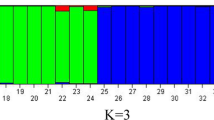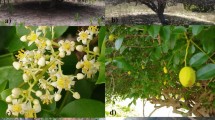Abstract
Inter-simple sequence repeat (ISSR) markers were used to analyze genetic diversity and relatedness of 15 germplasms of Fagopyrum tataricum. Samples representing 75 individuals were collected from a range of altitudes in the Western Himalaya. The 13 ISSR primers revealed 98.1% polymorphism among populations, whereas average polymorphism was extremely low (2.18%) within populations. The coefficient of population differentiation was 0.9750, with limited gene flow (N m) of 0.0128. The average PIC value of the ISSR markers was high (0.812), with a marker ratio of 0.65 and marker index of 6.66. The genetic diversity of F. tataricum significantly correlated with altitude and gene diversity, Shannon’s index, and the percentage of polymorphic bands. The genetic diversity among populations showed broad genetic base and provided a developmental strategy for crop improvement.



Similar content being viewed by others
References
Abdelmigid HM (2012) Efficiency of random amplified polymorphic DNA (RAPD) and inter-simple sequence repeats (ISSR) markers for genotype fingerprinting and genetic diversity studies in canola (Brassica napus). Afr J Biotech 11:6409–6419
Agostini G, Echeverrigaray S, Souza-Chies TT (2008) Genetic relationships among South American species of Cunila D. Royen ex L. based on ISSR. Plant Syst Evol 274:135–141
Anderson JA, Churchill GA, Autrique JE, Sorells ME, Tanksley SD (1993) Optimizing parental selection for genetic-linkage maps. Genome 36:181–186
Badiane FA, Diouf D, Sane D, Diouf O, Goudiaby V, Diallo N (2004) Screening cowpea (Vigna unguiculata (L.) Walp.) varieties by inducing water deficit and RAPD analyses. Afr J Biotechnol 3:174–178
Baloch FS, Cemal Kurt, Arioğlu H, Ozkan H (2010) Assaying of diversity among soybean (Glycin max (L.) Merr.) and peanut (Arachis hypogaea L.) genotypes at DNA level. Turk J Agric For 34:285–301
Barrett SCH, Kohn JR (1991) Genetics and evolutionary consequences of small population size in plants: Implications for conservation. In: Falk DA, Holsinger KE (eds) Genetics and conservation of rare plants. Oxford University Press, New York, pp 3–30
Behera TK, Singh AK, Staub Jack E (2008) Comparative analysis of genetic diversity in Indian bitter gourd (Momordica charantia L.) using RAPD and ISSR markers for developing crop improvement strategies. Sci Hortic 115:209–217
Chen YH (2003) Ecological characteristics and developing counter measures of Rheum Palmatum L. and R. tanguticum Maxim ex Bail. Qinghai Resour Dev Mark 19:159–161
Doyle JJ, Doyle JL (1987) A rapid DNA isolation procedure from small quantities of fresh leaf tissue. Phytochem Bull 19:11–15
Excoffier L, Smouse PE, Quattro JM (1992) Analysis of molecular variance inferred from metric distances among DNA haplotypes: applications to human mitochondrial DNA restriction data. Genetics 131:479–491
Excoffier L, Guillaume L, Schneider S (2006) Arlequin version 3.01: an integrated software package for population genetics data analysis. Computational and Molecular Population Genetic Lab, University of Berne
Gajera BB, Kumar N, Singh AS, Punvar BS, Ravikiran R, Subhash N, Jadeja GC (2010) Assessment of genetic diversity in castor (Ricinus communis L.) using RAPD and ISSR markers. Ind Crops Prod 32:491–498
Hamrick JL, Godt MJW (1989) Allozyme diversity in plant species. In: Brown AHD, Clegg MT, Kahler A, Weir BS (eds) Plant population genetic breeding and genetic resources. Sinauer Associates, Sunderland, pp 43–63
Hamrick JL, Godt MJW (1996) Effects of life history traits on genetic diversity in plant species. Phil Trans Royal Soc Lond B 351:1291–1298
Han J, Zhang W, Cao H, Chen S, Wang Y (2007) Genetic diversity and biogeography of the traditional Chinese medicine, Gardenia jasminoides, based on AFLP markers. Biochem Syst Ecol 35:138–145
He Q, Liang G, Xie J, Li W (2006) Genetic diversity analysis of wax apple germplasm by ISSR markers. Acta Hortic Sin 33:392–394
Hilfiker K, Holderegger R, Rotach P, Gugerli F (2004) Dynamics of genetic variation in Taxus baccata: local versus regional perspectives. Can J Bot 82:219–227
Hu Y, Wang L, Xie X, Yang J, Li Y, Zhang H (2010) Genetic diversity of wild populations of Rheum tanguticum endemic to China as revealed by ISSR analysis. Biochem Syst Ecol 38:264–274
Liu J, Wang L, Geng Y, Wang Q, Luo L, Zhong Y (2006) Genetic diversity and population structure of Lamiophlomis rotate (Lamiaceae), an endemic species of Qinghai–Tibet Plateau. Genetica 128:385–394
Liu WS, Dong M, Song ZP, Wei W (2009) Genetic diversity pattern of Stipa purpurea populations in the hinterland of Qinghai–Tibet Plateau. Ann Appl Biol 154:57–65
Maki M (2003) Population genetics of threatened wild plants. Japan J Plant Res 116:169–174
Manimekalai R, Nagarajan P (2006) Assessing genetic relationships among coconut (Cocos nucifera L.) accessions using inter simple sequence repeat markers. Sci Hortic 108:49–54
Marotti I, Bonetti A, Minelli M, Catizone P, Dinelli G (2007) Characterization of some Italian common bean (Phaseolus vulgaris L.) landraces by RAPD, semi-random and ISSR molecular markers. Genet Resour Crop Evol 54:175–188
Meloni M, Perini D, Filigheddu R, Binelli G (2006) Genetic variation in five Mediterranean populations of Juniperus phoenicea as revealed by inter-simple sequence repeat (ISSR) markers. Ann Bot 97:299–304
Nei M (1973) Analysis of gene diversity in subdivided populations. Proc Natl Acad Sci USA 70:3321–3323
Nei M (1978) Estimation of average heterozygosity and genetic distance from a small number of individuals. Genetics 89:583–590
Nkongolo KK (2003) Genetic characterization of Malawian cowpea (Vigna unguiculata (L.) Walp.) landraces: diversity and gene flow among accessions. Euphytica 129:219–228
Powell W, Morgante M, Andre C, Hanafey M, Vogel J, Tingey S, Rafalski A (1996) The comparison of RFLP, RAPD, AFLP and SSR (microsatellite) markers for germplasm analysis. Mol Breed 2:225–238
Reddy MP, Sarla N, Siddiq EA (2002) Inter simple sequence repeat (ISSR) polymorphism and its application in plant breeding. Euphytica 128:9–17
Reed DH, Frankham R (2003) Correlation between fitness and genetic diversity. Conserv Biol 17:230–237
Saeidi H, Sayed Tabatabaei BE, Rahimmalek M, Talebi-Badaf M, Rahiminejad MR (2008) Genetic diversity and gene-pool subdivisions of diploid D-genome Aegilops tauschii Coss. (Poaceae) in Iran as revealed by AFLP. Genet Resour Crop Evol 55:1231–1238
Singh DR, Srivastava AK, Srivastava A, Srivastava RC (2011) Genetic diversity among three Morinda species using RAPD and ISSR markers. Ind J Biotech 10:285–293
Singh S, Reddy KS, Jawali N (2000) PCR analysis of mungbean genotypes using anchored simple sequence repeat primers. pp 359–369 in: DAE-BRNS symposium on the use of nuclear and molecular techniques in crop improvement. BARC, Mumbai, India
Smith SC, Chin ECL, Shu OS, Wall S, Senior ML, Mitchel SE, Kresovich S, Ziegle (1997) An evaluation of SSR loci as molecular markers in maize (Zea mays L): comparison with data from AFLPs and pedigree. Theor Appl Genet 95:163–173
SPSS (2001) SPSS base 11.0 user’s guide. SPSS Inc., Chicago
Wang C, Zhang H, Qian ZQ, Zhao GF (2008) Genetic differentiation in endangered Gynostemma pentaphyllum (Thunb.) Makino based on ISSR polymorphism and its implications for conservation. Biochem Sys Ecol 36:699–705
Wang A, Yu Z, Yi D (2009a) Genetic diversity analysis of wild close relatives of barley from Tibet and the Middle East by ISSR and SSR markers. CR Biol 332:393–403
Wang HZ, Wu ZX, Lu JJ, Shi NN, Zhao Y, Zhang ZT, Liu JJ (2009b) Molecular diversity and relationships among Cymbidium goeringii cultivars based on inter-simple sequence repeat (ISSR) markers. Genetica 136:391–399
Wright S (1965) The interpretation of population structure by F-statistics with special regard to systems of mating. Evolution 19(3):395–420
Yeh F, Yang R, Boyle T (1999) Popgene version 1.32: Microsoft Windows-based freeware for population genetic analysis. Molecular Biology and Biotechnology Center, University of Alberta, Canada
Zietkiewicz E, Rafalski A, Labuda D (1994) Genome fingerprinting by simple sequence repeat (SSR)-anchored polymerase chain reaction amplification. Genomics 20:176–183
Acknowledgments
The authors express their gratitude to the Uttaranchal Council of Science and Technology and the Department of Science and Technology for providing support for all the experimental equipment. Thanks are also due to Dr. Vikas S. Jadon and Shashi Ranjan for collection of samples.
Author information
Authors and Affiliations
Corresponding author
Rights and permissions
About this article
Cite this article
Kishore, G., Pandey, A., Dobhal, R. et al. Population Genetic Study of Fagopyrum tataricum from Western Himalaya Using ISSR Markers. Biochem Genet 51, 750–765 (2013). https://doi.org/10.1007/s10528-013-9604-y
Received:
Accepted:
Published:
Issue Date:
DOI: https://doi.org/10.1007/s10528-013-9604-y




